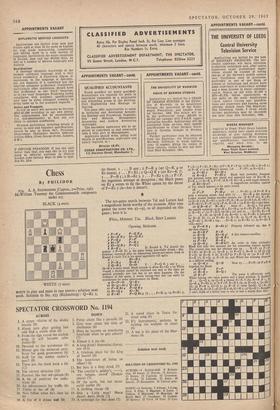Chess
By PHILIDOR
254. A. A. STAVRINIDES (Cyprus, 2=Prize, 1965 McWilliam Tourney for Commonwealth composers
under 21)
BLACK (4 men)
WHITE (7 men) WHITE to play and mate in two moves ; solution next week. Solution to No. 253 (Richenberg) : Q—Kt 2, no threat. I . . . B any ; 2 P—B 4 (set Q—K 4 or Kt mates). I . P x Kt ; 2 Q—Q R 2 (set Kt—K 7).
P—B 5 ; 2 R—Kt 5. P—Kt 5 cti ; P X P. An ingenious attempt at deception ; the Black pawn on Kt 4 seems to fix the White queen by the threat of P—Kt 5 ch—but it doesn't.
The ten-game match between Tal and Larsen had a magnificent finish worthy of the occasion. After nine games the score was 40-4i, so all depended on this game ; here it is.
White, MIKHAIL TAL. Black, BENT LARSEN. Opening, SICILIAN.
2 P—K 4 P—Q B 4
2 10—K 13 3 10—Q B 3 3 P—Q 4 P x P 4 KtxP P—K 3 5 Kt—Q B3 P—Q 3 6 B—K 3 . . . In Round 8, Tul played the quieter 6 P—K Kt 3, the game being peacefully drawn : this, however, occurred after an exhausting ninety-one-move draw in Round 7—now Tal is his usual aggressive self again. 6 . . . 10-13 3 7 P—B 4 B—K 2 8 Q-113 0-0 8 . . . P—Q R 3 and 9 . . . Q—B 2 is more usual. Black intends to allow Kt—Kt 5 by White —such a decision cannot be criticised one way or the other on general grounds; one just has to see what happens. On the evidence of this game, it seems wrong—but this can easily be overthrown by some improvement for Black, 0-0-0 Q—B ZO9 K1 (4)-Kt 5 Q—Kt r
it P—K Kt 4 P—Q R 3 r2 Kt—Q 4 Kt x Kt
13 13 X Kt P—Q Kt 4 13 . . . P—K 4; 14 P—Kt 5,
P x13; r5 PxKt, P x Kt; 16 P xB,P xP ch; r7 K—Kt 1, R—K 1; x8 P—K 51 is in White's favour. (18 P x P?; t9 R—Q 8.)
14 P—Kt 5 Kt—Q 2 r5 13-Q 3 P—Kt 5 Black had probably foreseen
this position some way ahead and expected now t6 Kt—K z, P—K 4; 17 B—K 3, P xP; 18 B x P, Kt—K 4 with equal chances,
• Kt—Q 5!! . . . A magnificent sacrifice, typical of Tal, which appears to be quite sound.
16 . . . PxKI
17 PxP P—B 4 17 . P—Kt. 3; 18 P—K R 4 with a winning attack. And after 17 . . . Kt—B 4 the famous Lasker double bishop sacrifice occurs, viz. 18 13 xP chi, K x13:
Q—II 5 ch,K—Kt 1; zo 13 xPI,K x13; as Q—R 6 ch,K--Kt r; 22 P—Kt 6), P xP; 23 Q xP ch, K—R ; 24 K R—Kt I and wins.
• Q R—K 12—B 2 After i8 B—Q 1, Tal gives the superb variation 19 Q—R 5. Kt—B 4; zo B x Kt P 1, Kt x B ch;
21 K—Kt r! (2r P x Kt t, Q—B z chl and zz Q x B), Kt x R
(zr . K x B; 22 Q—R 6 cis, K—Kt r; 23 P-1(t. 6 followed by It —K Kt r); 22 P—Kt 6!, K x 13; 23 01._.xP eh, K—B 3; 24 P—Kt 7, R—B 2 (24 . • . B—K 2; 25 R—Kt 1); 25 P—Kt 8 mate!
rg P—K R 4 the best chance.
20 Bxn P RxlI
21 R x B Kt—K 4! A fine counter-sacrifice.
22 Q—K 4 Q—K B
23 P x Kt 11—B 5
24 Q—R 3 8-1 6?? An error in time pressure; Black had only five minutes for his remaining sixteen moves. The correct line was the obvious one 24 . . . B X P; 25 P xP, R BI; z6 R—K xI, Q—B 5; 27 P—Q 7, B—B 2; 28 Q x RxQ; 29 R—K 8 ch, B x R;• 3o P x B—Q ch (30 R xB eh?, It—B r l), It x Q; 3t H x R ch, and White has winning chances in a difficult ending. 25 Q—K 2 Q x R Now 25 ... B xP; 26 P xP is hopeless for Black.
• Q x R P x P 27 R—K r R—Q r
28 R x P . . . The game is effectively over White havil two extra pawns and a good position. It finished 28 Q 3; 29 Q-14 4 (threat It—K 8 ch), 12—K B r ; 30 Q—K 4, P— Ct 6; 31 R P xp, R—B 8 ch; 32 K-01 2, Q —Kt S ch; 33 P—B 3, Q—Q 3; 34 B—I3 5! (neat finish), Q x B; 35 R—K 8 ch, Il—B s; 36 Q—K 6 cis, K—R 1; 37 Q—B 7!, Resign" can't think of a better way to win or lose a match than this. B—Kt 2!
Properly followed up, this is






































 Previous page
Previous page